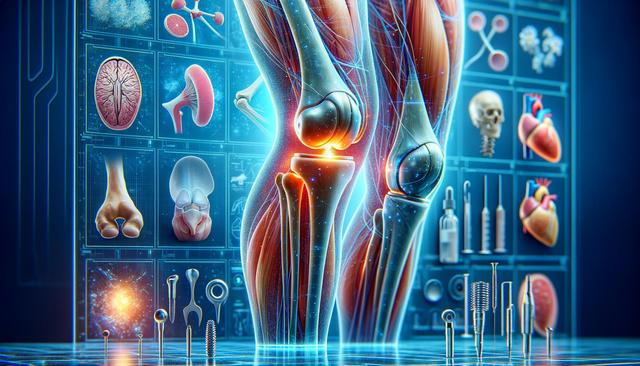Understanding Knee Replacement Surgery
Knee replacement, also known as knee arthroplasty, is a medical procedure designed to relieve pain and restore function in severely diseased knee joints. Typically recommended when other treatments such as physical therapy, medications, or lifestyle modifications no longer provide relief, this surgery involves removing damaged cartilage and bone from the knee and replacing it with artificial components. These prosthetic parts are usually made of metal alloys, high-grade plastics, and polymers, and are designed to replicate the movement of a natural knee.
The decision to undergo knee replacement should be made in consultation with an orthopedic surgeon, based on the patient’s pain level, mobility limitations, and overall health. It’s not limited to older adults; younger individuals with serious joint damage due to injury or medical conditions like rheumatoid arthritis may also be candidates. The procedure has evolved over the years, with modern techniques offering more precision, shorter hospital stays, and improved recovery outcomes.
When Is Knee Replacement Necessary?
Not everyone with knee pain requires surgery. However, knee replacement becomes a consideration when the joint damage significantly interferes with daily life. Common conditions leading to this need include:
- Osteoarthritis – the most prevalent cause, particularly in older adults
- Rheumatoid arthritis – an autoimmune disorder causing chronic inflammation
- Post-traumatic arthritis – resulting from a knee injury
Signs that knee replacement might be necessary include chronic pain that persists even at rest, difficulty in climbing stairs or walking short distances, and noticeable deformity or swelling of the joint. In many cases, patients have already tried other interventions such as corticosteroid injections, bracing, or physical therapy without satisfactory results.
Understanding the severity of the condition and the impact on daily life is essential. A detailed evaluation including X-rays, MRI scans, and lab tests helps determine the extent of joint damage and whether surgery is the most effective option moving forward.
Types of Knee Replacement Procedures
There are several types of knee replacement surgeries, and the choice depends on the patient’s specific condition and lifestyle needs. The most common types include:
- Total Knee Replacement (TKR): The entire knee joint is replaced with artificial components.
- Partial Knee Replacement (PKR): Only the damaged part of the knee is replaced, preserving more natural tissue.
- Revision Knee Replacement: A second surgery done if the original implant fails or wears out over time.
Minimally invasive techniques are becoming more common, offering smaller incisions and potentially quicker recoveries. However, not all patients qualify for less invasive methods. Surgeons consider factors like age, weight, bone quality, and overall health before recommending a specific surgical approach.
Each procedure comes with its own set of risks and benefits, and understanding these options allows patients to make informed decisions in collaboration with their healthcare provider.
Recovery and Rehabilitation
Post-surgery recovery is a critical phase in ensuring the success of knee replacement. Most patients begin physical therapy within 24 hours of surgery to regain mobility and strength. A structured rehabilitation plan typically includes:
- Range-of-motion exercises
- Strength training for surrounding muscles
- Walking aids like crutches or walkers during initial recovery
Full recovery can take several weeks to months, depending on the type of surgery and the patient’s baseline health. Adhering to physical therapy and follow-up appointments is essential for optimal outcomes. Patients are often advised to avoid high-impact activities but can gradually return to low-impact exercises like swimming or cycling.
Complications are rare but can include infection, blood clots, or implant issues. Prompt medical attention for unusual pain, swelling, or redness helps address potential problems early. Clear communication with the care team throughout recovery supports a smoother healing process.
Living with a Knee Replacement
Knee replacement has proven to significantly improve quality of life for many individuals suffering from chronic joint pain. After recovery, most patients report reduced pain, increased mobility, and better participation in daily activities. While the implant may not feel exactly like a natural knee, it provides substantial relief and functionality.
Patients are encouraged to adopt a healthy lifestyle to prolong the lifespan of the implant. This includes:
- Maintaining a healthy weight to reduce joint stress
- Engaging in low-impact physical activities
- Regular check-ups to monitor implant condition
With proper care, modern implants can last 15 to 20 years or more. New materials and techniques continue to improve outcomes, making knee replacement a viable option for a growing number of people. However, setting realistic expectations and understanding the limitations is important for long-term satisfaction.
Ultimately, knee replacement is not just about eliminating pain—it’s about regaining independence and enhancing overall well-being. For many, it offers a renewed sense of freedom and the ability to return to enjoyable activities.
Conclusion
For individuals struggling with persistent knee pain and loss of mobility, knee replacement offers a well-established path to relief and improved function. By understanding the procedure, assessing personal needs, and following a dedicated recovery plan, patients can make informed decisions that align with their lifestyle goals. While every journey is unique, many find that knee replacement brings a renewed sense of movement and confidence in their daily lives.








